Three versions of Physical, across four decades
Can I hear the difference?
To save you wasting your time, Yes I can, reasonably easily. Demonstrably and provably so. On a double-blind basis.
Comparison of the song Physical on three Physical CDs
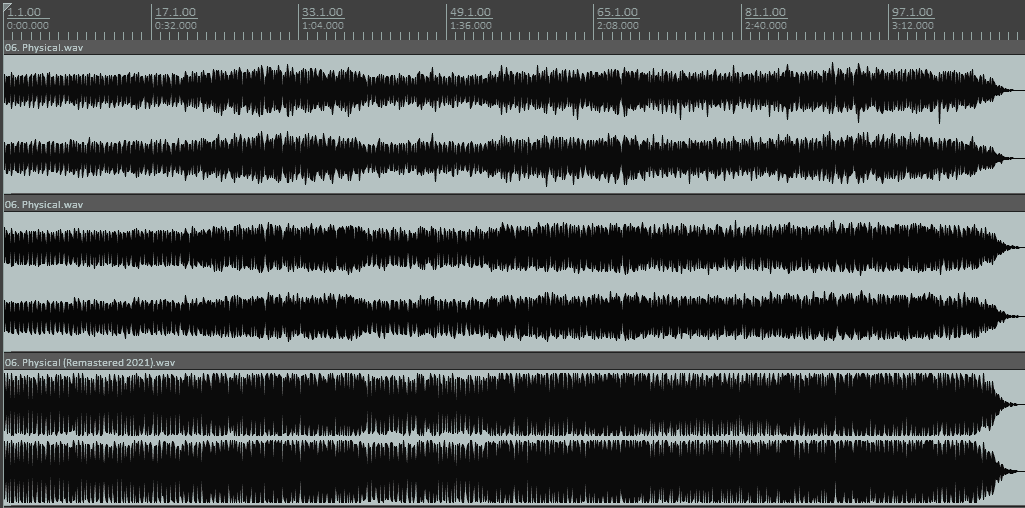
I loaded the song Physical from each of the three CD rips into a DAW. The waveform envelope sort of shows you the loudness of the track against time. The Primary Wave mastering is at the bottom, the Japanese 1984 version is at the top. This envelope tells you nothing about the tonal balance or the clarity of the sounds, but you can immediately see that there is a difference.
The difference is that on the most recent release the track is much more at the same level, which can make it a little bit relentless. Even on Physical, Olivia needs room to build the ebb and flow of the song. For instance, around 0:36 she pulls back a little bit with the quieter "I took you to an intimate restaurant. Then to a suggestive movie", before later on letting rip with "Let's get Physical" later on. The intimate restaurant is meant to be quieter, it's setting the scene. I know it's only pop music rather than a quiet second movement against a thundering classical finale, but this tension is still part of the whole. We managed to get this onto vinyl in 1981 retaining the dynamic tension in the track. Even non-classical music benefits from the interplay between the loud parts and the softer parts.
I don't really get why PW feel the need to reduce the difference between loud and soft on the CD issues. Volume compression is like scrambling an egg, once done, you can't undo the effect. It's also easy to do semi-automatically, it's been done on the radio for years, so it would be easy to do on the fly for other distribution platforms where Olivia's songs might be competing with more recent tracks. Physical media sales are a minority sport nowadays. According to Forbes
CD sales have fallen by 80% in the US, particularly among younger buyers.
However, all is not completely lost for the CD, and reports of its death may be a little premature. The silver discs that are still selling tend to be music that appeals to older purchasers who to still value owning physical media or who enjoy the higher audio quality of the CD format, which is still far better than MP3s.
That includes a fair number of us Olivia Newton-John fans, I guess, with due respect to those of us who have come to love her after her heyday. I'd imagine Primary Wave expect to sell deluxe edition CDs to existing fans, and they'd expect them to occasionally sit down in front of the stereo, turn the lights down low and give Olivia their undivided attention. For sure, Primary Wave will sell more tracks on streaming platforms, and perhaps that's the place to master for a reduced dynamic range, both to compete with more modern songs playing back to back with Physical on Spotify, and also because such users may be playing back in noisy locations. But on CD, I don't see that it would hurt to keep the dynamics that Olivia and John Farrar intended back in 1981. These are premium CD editions, sold at a premium price. You can expect people to sit down and listen properly - if they want to listen on the move they'll probably use their phone and streaming like everybody else.
By no means does this count as brickwalled, it's still a decent listen, but perhaps not the definitive digital copy in my view. I'd like my dynamic tension back, both within the track and between tracks on the album. Like they did on vinyl in 1981 and the 1984 Japanese CD ;) There are other aspects to good sound than dynamics. The Primary Wave release of Physical sounds more tonally balanced1 than the 1984 Japanese CD to me. Some listeners may prefer it for that reason alone.
At the time of writing (Oct 2022) we only have two Primary Wave deluxe editions: Physical Deluxe Edition and If Not For You Deluxe Edition. I don't have the Primary Wave Greatest Hits. I wondered if this reduction of dynamics is systematic or one-off with Physical, so I experimented with one song from the If Not For You CD.
Comparison of the song Where Are You Going To My Love on 48 Original Tracks and the Primary Wave If Not for You CD
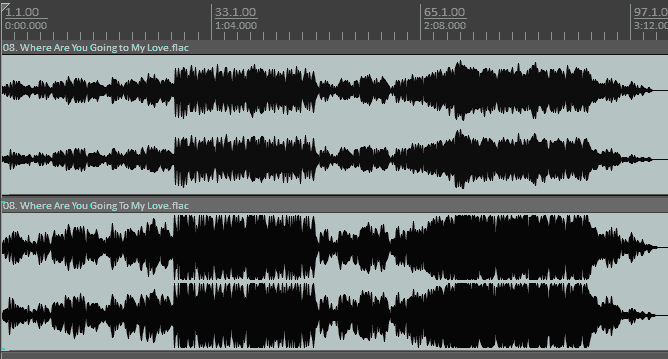
I repeated the exercise on the song Where Are You Going To My Love, firstly from the EMI 48 Original Tracks CD and then from the new If Not For You Deluxe Edition. There's a hint of the same sort of thing going on, though overall this doesn't sound bad at all. The peak around 2:18 'come back to me' is a bit OTT with the Primary Wave edition and I prefer the EMI CD, but I could live with either. I did the ABX sound check on these tracks too.
back to the four waves of digitally remastered Olivia CDs
The Physical CDs
These are pictures of the actual Compact Discs that I ripped to source the digital files. In all cases Accurip confirmed the checksum of the digital files matched many other people's rips of these discs.
Version 1 - the Japanese early release CDP35-3065
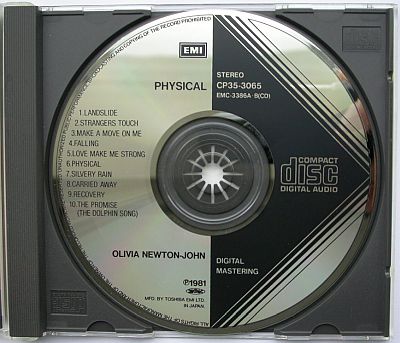
The Japanese black triangle edition of Physical, CP35-3065, from 1984, two years after the commercial debut of the CD medium, and three years after the album's release. The smash hit album was one of the early priorities to get out on CD, and Olivia has had a lot of success in Japan. Clearly for the domestic market, the back cover has no English subtitles for the Japanese character song titles. Running the program DR2 on this gives a log showing album DR14 and Physical track DR15.
Version 2 - the MCA release
In an ideal world I'd use the earlier MCA release of Physical in 1985, MCAD-5229 rather than this budget release MCAD-31110, but this is the CD I have.
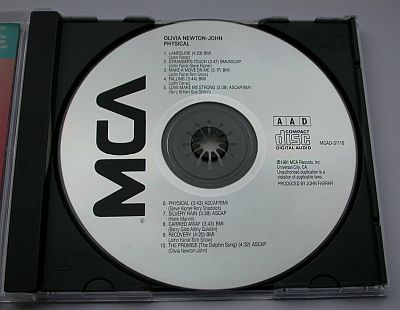
Running the program DR on this gives a log showing album DR11 and Physical track DR11.
Version 3 - the Primary Wave release
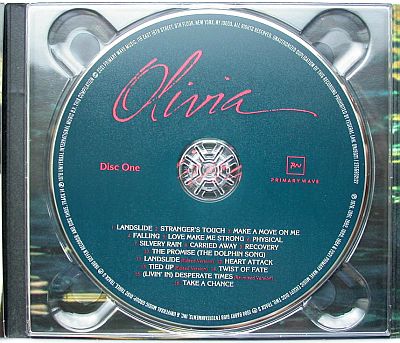
This is the latest and greatest remastered deluxe edition of Physical from Primary Wave, which comes with a bonus disc of lots of goodies, and a DVD of Olivia's videogram and 1982 concert. Which is lovely as long as you remember to hit the mute button at the end because of the full-scale linear timecode in audio just to wake you up at the end ;) The CDs are fine.
Running the program DR on this gives a log showing album DR09 and Physical track DR09. For this log I deleted the extra tracks to compare like with like.
back to the four waves of digitally remastered Olivia CDs
listening test
The first question you have to ask a random fellow on t'internet who is asserting a sonic difference between different copies of Olivia's CDs, is the obvious. Can YOU hear a difference? If so, prove it. So let's deal with that first. The good people at Hydrogenaudio are skeptics of anybody's claim to hear a difference between anything, and have produced a tool called ABX comparator to perform a verifiable double-blind test. ABX comparator takes care of level-matching the tracks, as people tend to favour louder sounds, even if the digital source were the same. ABX takes out that confounding variable. Since I am claiming to hear a difference between two versions of a track on different CD masterings, rather than the difference between $10 cables and $1000 cables I can do an ABX on my own using their tool.
In the blue corner, a CD made at the dawn of the medium, the Japanese black triangle edition of Physical, CP35-3065. In the red corner, the latest Primary Wave release. I am going to have to confess here that I don't particularly care for the title track, Physical, and I am also normally more a slower songs sort of guy. In an ABX test you really have to like the track because you are going to hear it (or bits of it) 16 times, and I couldn't face Physical that much. I chose Love Make Me Strong, it's similarly upbeat to Physical, I like the track. I identified the difference between tracks correctly in 16/16 trials in a rapid-fire sequence. In other words, they aren't identical, to my ears, and this is statistically verified. This is better than the 95% confidence interval normally required for scientific confirmation of a hypothesis. This was my second trial, done and dusted in 7 minutes, so the difference doesn't involve straining to hear tiny minutiae. It's the second trial because I failed to tick the Replaygain box in the ABX comparator the first go (results also linked lower down, for the sake of transparency). I was a much more experienced ABX listener the second time because I have done a few other ABX comparisons on Olivia in the course of this project. I don't ever want to do any more ABX testing now, it's not how I want to listen to Olivia ;) I didn't p-hack the results by taking endless runs at it. Nothing would please me more than for the latest release to be the definitive version, but it is not to be for this listener, and the difference is real.
ABX results
Love Make Me Strong (Physical) test results I did have to redo this checking the RG box in the ABX comparator, I wasn't sure it picked up replaygain from the file - although it took 2 mins longer than without ticking the box I ended up with a 16/16 score, not 15/16 as the first time (w/o RG box ticked). You can verify the results with the ABX validator. You do, of course, have to trust me that the source files are what they say they are. I had previously run replaygain to scan on a per-track basis using these settings.
I did this again on If Not For You with the song Where Are you Going To My Love. Results are here. A was the Festival 1993 version and B was the Primary Wave release. The preference is much less here - the variation between track levels is quite large on the Festival release, even for me. PW have reduced that.
Equipment used

I ripped the CDs to lossless FLAC individual tracks using CUETools. Accurip gave the thumbs up on 100% accurate in both cases. I used a Behringer Xenyx 302 USB audio interface to Windows 11 running Foobar2k v 1.6.10 driving AKG K240 Studio headphones (which look of the same family as what Olivia used in the Deeper Than The Night video) directly from the 3.5mm headphones socket of the Xenyx 302. Nothing exceptionally audiophile, all workmanlike kit you'd expect to see in a low-end musician's rig rather than featured in Stereophile or Hi-Fi News.
back to the four waves of digitally remastered Olivia CDs
- Good tonal balance is subjective, I am not an audio professional. I have heard Olivia live, and indeed speaking, unamplified, IRL. Whether that qualifes me to opine on the flatness of the PW release is debatable, as I've spent half a lifetime listening to her recorded, and a lot of that on vinyl records which aren't noted for flatness of frequency response. ↩
-
I used TT DR offline meter from the links menu on https://dr.loudness-war.info/. That is deprecated these days for the difference between Peak level and LUFS as I used with the comparison on the Totally Hot album. People that care aboout dynamic range are familiar with the DR program because it was part of a campaign to raise awareness of the loudness wars issue, and the CD DR database uses that deprecated method.↩